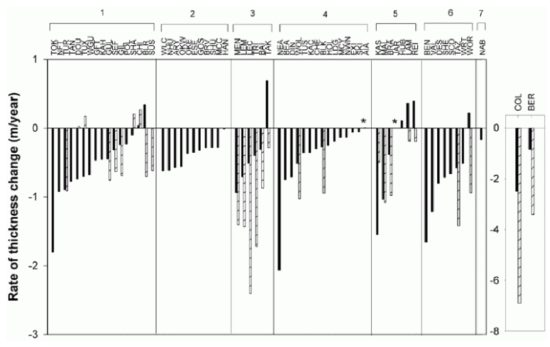5.4: Observations of Melting Ice
- Page ID
- 7014
\( \newcommand{\vecs}[1]{\overset { \scriptstyle \rightharpoonup} {\mathbf{#1}} } \)
\( \newcommand{\vecd}[1]{\overset{-\!-\!\rightharpoonup}{\vphantom{a}\smash {#1}}} \)
\( \newcommand{\id}{\mathrm{id}}\) \( \newcommand{\Span}{\mathrm{span}}\)
( \newcommand{\kernel}{\mathrm{null}\,}\) \( \newcommand{\range}{\mathrm{range}\,}\)
\( \newcommand{\RealPart}{\mathrm{Re}}\) \( \newcommand{\ImaginaryPart}{\mathrm{Im}}\)
\( \newcommand{\Argument}{\mathrm{Arg}}\) \( \newcommand{\norm}[1]{\| #1 \|}\)
\( \newcommand{\inner}[2]{\langle #1, #2 \rangle}\)
\( \newcommand{\Span}{\mathrm{span}}\)
\( \newcommand{\id}{\mathrm{id}}\)
\( \newcommand{\Span}{\mathrm{span}}\)
\( \newcommand{\kernel}{\mathrm{null}\,}\)
\( \newcommand{\range}{\mathrm{range}\,}\)
\( \newcommand{\RealPart}{\mathrm{Re}}\)
\( \newcommand{\ImaginaryPart}{\mathrm{Im}}\)
\( \newcommand{\Argument}{\mathrm{Arg}}\)
\( \newcommand{\norm}[1]{\| #1 \|}\)
\( \newcommand{\inner}[2]{\langle #1, #2 \rangle}\)
\( \newcommand{\Span}{\mathrm{span}}\) \( \newcommand{\AA}{\unicode[.8,0]{x212B}}\)
\( \newcommand{\vectorA}[1]{\vec{#1}} % arrow\)
\( \newcommand{\vectorAt}[1]{\vec{\text{#1}}} % arrow\)
\( \newcommand{\vectorB}[1]{\overset { \scriptstyle \rightharpoonup} {\mathbf{#1}} } \)
\( \newcommand{\vectorC}[1]{\textbf{#1}} \)
\( \newcommand{\vectorD}[1]{\overrightarrow{#1}} \)
\( \newcommand{\vectorDt}[1]{\overrightarrow{\text{#1}}} \)
\( \newcommand{\vectE}[1]{\overset{-\!-\!\rightharpoonup}{\vphantom{a}\smash{\mathbf {#1}}}} \)
\( \newcommand{\vecs}[1]{\overset { \scriptstyle \rightharpoonup} {\mathbf{#1}} } \)
\( \newcommand{\vecd}[1]{\overset{-\!-\!\rightharpoonup}{\vphantom{a}\smash {#1}}} \)
\(\newcommand{\avec}{\mathbf a}\) \(\newcommand{\bvec}{\mathbf b}\) \(\newcommand{\cvec}{\mathbf c}\) \(\newcommand{\dvec}{\mathbf d}\) \(\newcommand{\dtil}{\widetilde{\mathbf d}}\) \(\newcommand{\evec}{\mathbf e}\) \(\newcommand{\fvec}{\mathbf f}\) \(\newcommand{\nvec}{\mathbf n}\) \(\newcommand{\pvec}{\mathbf p}\) \(\newcommand{\qvec}{\mathbf q}\) \(\newcommand{\svec}{\mathbf s}\) \(\newcommand{\tvec}{\mathbf t}\) \(\newcommand{\uvec}{\mathbf u}\) \(\newcommand{\vvec}{\mathbf v}\) \(\newcommand{\wvec}{\mathbf w}\) \(\newcommand{\xvec}{\mathbf x}\) \(\newcommand{\yvec}{\mathbf y}\) \(\newcommand{\zvec}{\mathbf z}\) \(\newcommand{\rvec}{\mathbf r}\) \(\newcommand{\mvec}{\mathbf m}\) \(\newcommand{\zerovec}{\mathbf 0}\) \(\newcommand{\onevec}{\mathbf 1}\) \(\newcommand{\real}{\mathbb R}\) \(\newcommand{\twovec}[2]{\left[\begin{array}{r}#1 \\ #2 \end{array}\right]}\) \(\newcommand{\ctwovec}[2]{\left[\begin{array}{c}#1 \\ #2 \end{array}\right]}\) \(\newcommand{\threevec}[3]{\left[\begin{array}{r}#1 \\ #2 \\ #3 \end{array}\right]}\) \(\newcommand{\cthreevec}[3]{\left[\begin{array}{c}#1 \\ #2 \\ #3 \end{array}\right]}\) \(\newcommand{\fourvec}[4]{\left[\begin{array}{r}#1 \\ #2 \\ #3 \\ #4 \end{array}\right]}\) \(\newcommand{\cfourvec}[4]{\left[\begin{array}{c}#1 \\ #2 \\ #3 \\ #4 \end{array}\right]}\) \(\newcommand{\fivevec}[5]{\left[\begin{array}{r}#1 \\ #2 \\ #3 \\ #4 \\ #5 \\ \end{array}\right]}\) \(\newcommand{\cfivevec}[5]{\left[\begin{array}{c}#1 \\ #2 \\ #3 \\ #4 \\ #5 \\ \end{array}\right]}\) \(\newcommand{\mattwo}[4]{\left[\begin{array}{rr}#1 \amp #2 \\ #3 \amp #4 \\ \end{array}\right]}\) \(\newcommand{\laspan}[1]{\text{Span}\{#1\}}\) \(\newcommand{\bcal}{\cal B}\) \(\newcommand{\ccal}{\cal C}\) \(\newcommand{\scal}{\cal S}\) \(\newcommand{\wcal}{\cal W}\) \(\newcommand{\ecal}{\cal E}\) \(\newcommand{\coords}[2]{\left\{#1\right\}_{#2}}\) \(\newcommand{\gray}[1]{\color{gray}{#1}}\) \(\newcommand{\lgray}[1]{\color{lightgray}{#1}}\) \(\newcommand{\rank}{\operatorname{rank}}\) \(\newcommand{\row}{\text{Row}}\) \(\newcommand{\col}{\text{Col}}\) \(\renewcommand{\row}{\text{Row}}\) \(\newcommand{\nul}{\text{Nul}}\) \(\newcommand{\var}{\text{Var}}\) \(\newcommand{\corr}{\text{corr}}\) \(\newcommand{\len}[1]{\left|#1\right|}\) \(\newcommand{\bbar}{\overline{\bvec}}\) \(\newcommand{\bhat}{\widehat{\bvec}}\) \(\newcommand{\bperp}{\bvec^\perp}\) \(\newcommand{\xhat}{\widehat{\xvec}}\) \(\newcommand{\vhat}{\widehat{\vvec}}\) \(\newcommand{\uhat}{\widehat{\uvec}}\) \(\newcommand{\what}{\widehat{\wvec}}\) \(\newcommand{\Sighat}{\widehat{\Sigma}}\) \(\newcommand{\lt}{<}\) \(\newcommand{\gt}{>}\) \(\newcommand{\amp}{&}\) \(\definecolor{fillinmathshade}{gray}{0.9}\)Sea Ice
One of the direct consequences of a climate that is becoming warmer on average is that global repositories of ice are beginning to melt. Measuring the amount of melting takes time and requires repeated observations because ice caps and glaciers have natural seasonal cycles (more ice in the winter, less ice in the summer). Below is a schematic figure showing data collected for forty years in the Arctic. Polar sea ice thinned by an average of over a meter during that time!


- Click for a text description of Figure 5.4.
-
Sea ice draft is the thickness of the part of the ice that is submerged under the sea. Comparison of sea ice draft data acquired on submarine cruises between 1993 and 1997 with similar data acquired between 1958 and 1976 indicates that the mean ice draft at the end of the melt season has decreased by about 1.3m in most of the deep water portion of the Arctic Ocean, from 3.1m in 1958–1976 to 1.8 m in the 1990s. In summary: ice draft in the 1990s is over a meter thinner than two to four decades earlier. The main draft has decreased from over 3 meters to under 2 meters, and the volume is down by some 40%.
Credit: D. A. Rothrock, Y. Yu, and G. A. Maykut, Thinning of the Arctic Sea Ice Cover, University of Washington, 1999.
Glacial ice
A survey of over 60 glaciers in Alaska has shown an alarming trend. On average, glaciers have been thinning from 1950 onwards. The rate of thinning has rapidly increased during the last ten years or so. Be careful to note the difference between discussing the amount of thinning and the rate of thinning. The amount of thinning is found by measuring the thickness of ice at two different times and subtracting. The rate of thinning refers to how fast the ice is getting thinner. Mathematically, the rate of thinning is the derivative of the amount of thinning, just like velocity is the derivative of displacement if you want to think of it in terms of simple motion. So, even if the rate of thinning was a constant number, say 10 centimeters per year, the amount of thinning would still be increasing every year (by 10 cm). The two figures below show a map of the glaciers from Arendt et al.'s 2002 study of Alaskan glaciers and a bar graph that denotes the rate of thinning for two different time periods of each glacier in the study. The observation of an increase in the rate of thinning is like an acceleration, to continue the analogy to simple motion. It means that glaciers in the past 10 years have been thinning even faster than they used to be.

- Click for a text description of Figure 5.5
-
Location of 67 surveyed glaciers, shown in black, separated into seven geographic regions: 1, Alaska Range; 2, Brooks Range; 3, Coast Range; 4, Kenai Mountains; 5, St. Elias Mountains (includes Eastern Chugach Range); 6, Western Chugach Range; and 7, Wrangell Mountains. Glacier names associated with three-letter codes are in table S1. Fifty-five glaciers are located entirely in Alaska, 11 span the border between Alaska and Canada ( Yukon Territory and northwest British Columbia), and one is entirely located in Yukon Territory. The total surface area of glaciers in our sample is about 18,000 km2; the total area of glacier ice in Alaska, Yukon, and northwest British Columbia (north of 54°N latitude), shown in gray, is 90,000 km2. Glaciers outside the seven regions account for 0.2% of the total glacier area.
Credit: Arendt et al., 2002, Rapid Wastage of Alaska Glaciers, Science 297, p. 382.

- Click for a text description of Figure 5.6.
-
Rate of glacier-wide average thickness change of 67 glaciers in Alaska during the early period (1950 to 1995; solid black bars) and 28 glaciers during the recent period (1995 to 2001; hatched bars). Glaciers are arranged according to their regions as given in the figure above; two large glaciers are plotted separately because of their exceptionally high rates of thinning. Asterisks denote thickness changes not resolved by the scale of the plot.
Credit: Arendt et al., 2002, Rapid Wastage of Alaska Glaciers, Science 297, p. 382.
Consequences of melting ice
What happens when ice melts? That's easy: it turns into water. Where does the water go? Eventually, it finds its way into the ocean. In the case of Arctic sea ice, the contribution of melt to global sea level is negligible. That's because this ice is already sitting in the water. The density of ice is less than that of water, but not by a whole lot. On the other hand, when Alaskan glaciers melt, this extra water does increase sea level around the world because the ice had been trapped on the land before. The activity below demonstrates this principle in a simple way.
Try this!
- Get a clear glass and fill it about half full with water. A pint glass works well for this.
- Mark on the side with a china marker the level of the water.
- Put a few ice cubes in the water and make another mark where the level of the water is now.
- Observe how much of the ice is above the top of the water and how much is hanging below. The amount below is called the "draft."
- Let your glass sit around until the ice melts. Notice that the level of the water is not too much different from the higher mark you made. Melting the floating ice doesn't raise the water level very much compared the initial amount it was raised by adding the ice to the system in the first place.


